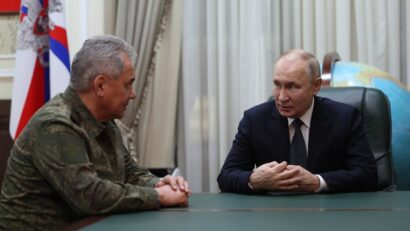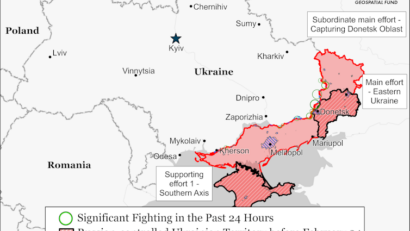
Ukraine war: $60 billion in US military aid a major morale boost but no certain path to victory
It took months of delays and desperate pleas from Ukraine, but the US House of Representatives has finally passed a bill authorising US$60 billion (£50 billion) worth of military aid to Ukraine.
The bill is still subject to Senate approval and then needs to be signed into law by the US president, Joe Biden. But given the Senate’s previous approval of a similar measure and Biden’s vehemence of the need to support Ukraine, this should be a formality.
So, will US support save Ukraine from what might otherwise have been an all-but-certain defeat? The answer is not straightforward. What is certain is that it gives Ukraine a breathing space on the battlefield – and an opportunity to halt a slow but steady Russian offensive that has netted Moscow substantial territorial gains in recent months.
Apart from Senate and presidential approval, there are still some logistical difficulties to overcome. Most of the urgently needed military hardware, especially ammunition, is already stored in Poland. But it needs to be transported to the frontlines and incorporated into defence strategy and tactics by Ukrainian troops there.
But, given that they are now secure in the knowledge that supplies arrive soon, Kyiv will be less compelled to ration ammunition as it has been forced to do recently. Together with the morale boost for troops, this means that improvements in the situation on the front are likely – even before new US supplies will arrive.
Political will
How much more than a reprieve will this aid package really provide? This depends on several factors. The sustainability of military and other forms of aid is not simply a financial question. It is above all one of political will.
The months-long delay in the US Congress was primarily an issue of domestic political posturing in a presidential election year. After a series of mixed signals over recent months, Donald Trump backed Republican House speaker Mike Johnson in his decision to bring the Ukraine aid bill to a vote on Saturday. But more Republican members of the House opposed the bill than supported it.
Moreover, if Trump were to return to the White House after November’s election, his personal grudges against Ukraine and its president, Volodymyr Zelensky, are well known. This – as well as his past expressions of admiration for Vladimir Putin – make him, and the US, an uncertain long-term ally.
Earlier difficulties in the EU to pass its multi-annual Ukraine support package were caused by the pro-Russian leanings of just one among its 27 heads of state and government. Hungary’s Viktor Orbán now seems to have found a like-minded ally in Slovakia’s prime minister, Robert Fico, who has opposed efforts to provide more military aid to Ukraine, instead arguing that Kyiv should seek a negotiated settlement with Moscow.
European parliamentary elections in June are likely to return a larger proportion of pro-Russian members to the parliament who are opposed to open-ended support for Ukraine. While their influence on funding decisions is much more limited, they could certainly create significant problems in Ukraine’s EU accession negotiations.
Economic capacity
To add to that, the US and Europe’s defence industrial bases are nowhere near sufficiently geared up to match Russia’s vastly increased military output and its own strengthened defence sector. Russia’s rapid transition to a war economy has been additionally buoyed by Iranian, North Korean and Chinese support and weapons supplies.
There is some confidence that production capacity in the US and Europe, as well as in Ukraine, will significantly increase as of 2025. At the same time there is some doubt whether Russia will be able to sustain its current rate of military output, especially if the US and EU manage to dissuade China and Iran from further aiding Moscow.
But even in an optimistic scenario of sustained investments in the defence industrial base of the collective west and increasing Russian economic and logistical difficulties to sustain its defence sector, a gamechanging shift in the balance of power is unlikely in the near future.
Russia holds the initiative, for now
In addition, Russia, at the moment in any case, still has clear manpower advantages. It also enjoys air superiority in light of depleted Ukrainian air defence systems, and has the operational momentum on the battlefield. If anything, Russia will now double down on its current offensive pushes.
Battlefield advantage: Russian president, Vladimir Putin, with his defence minister, Sergei Shoigu.
EPA-EFE/Gavril Grigorov/Sputnik/Kremlin pool
It will want to press home these advantages before Ukraine’s defences are bolstered by the arrival of military aid, and potentially more US military advisers.
A final point worth reiterating is that Ukraine is not the only major security crisis that the west is facing. At the same time as the US House of Representatives passed its Ukraine support bill, it also voted in favour of military support for Israel and Taiwan, potentially authorising a combined total of some US$100 billion (£81 billion). In light of an existing $34 trillion federal debt balance – which increases by US$1 trillion every 100 days – the long-term sustainability of such aid packages is in question, and not only during a potential second Trump presidency.
Taken together, all this probably means that predictions that Ukraine will win the war against Russia within a year on the back of this additional US support are at best overly optimistic and at worst dangerously delusional. A more realistic assessment would be that the resolve that the west seems to be rediscovering more widely in its support for Ukraine will give Kyiv an opportunity to improve its negotiating position when the two sides finally sit down to bring this war to an end.
But even this could turn out to be wishful thinking. Given the continuing rhetoric of victory in Moscow and Kyiv, another forever-war might just have become more sustainable – for now. Läs mer…


